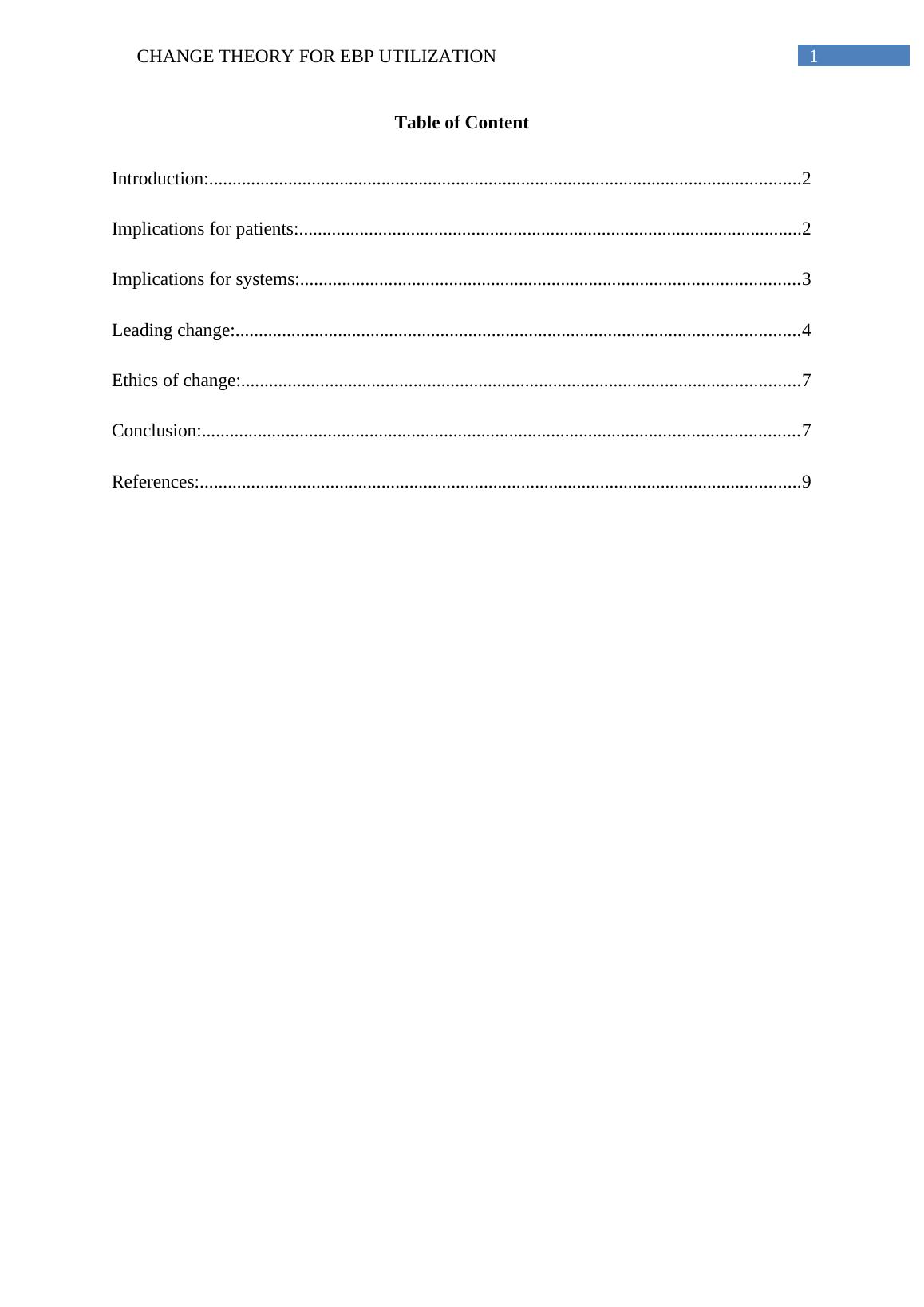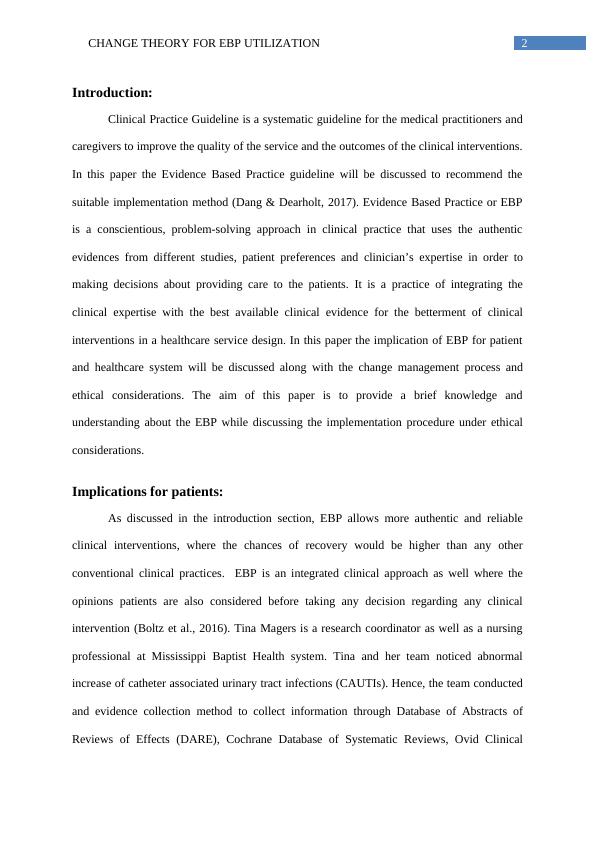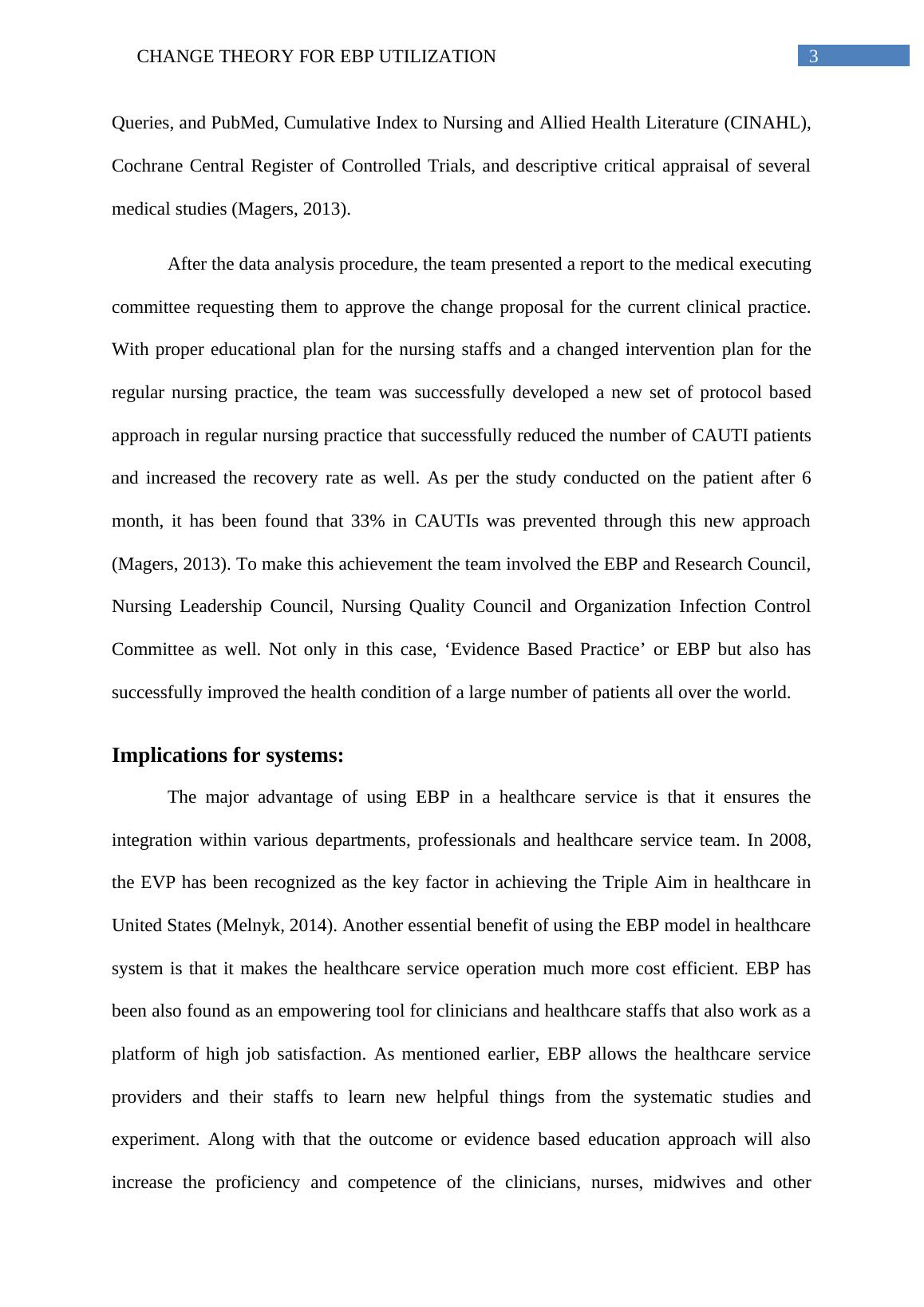Change Theory for EBP Utilization
Added on 2022-12-20
11 Pages2128 Words9 Views
Running head: CHANGE THEORY FOR EBP UTILIZATION
Change theory for EBP utilization
Name of the Student
Name of the University
Author note
Change theory for EBP utilization
Name of the Student
Name of the University
Author note

1CHANGE THEORY FOR EBP UTILIZATION
Table of Content
Introduction:...............................................................................................................................2
Implications for patients:............................................................................................................2
Implications for systems:...........................................................................................................3
Leading change:.........................................................................................................................4
Ethics of change:........................................................................................................................7
Conclusion:................................................................................................................................7
References:.................................................................................................................................9
Table of Content
Introduction:...............................................................................................................................2
Implications for patients:............................................................................................................2
Implications for systems:...........................................................................................................3
Leading change:.........................................................................................................................4
Ethics of change:........................................................................................................................7
Conclusion:................................................................................................................................7
References:.................................................................................................................................9

2CHANGE THEORY FOR EBP UTILIZATION
Introduction:
Clinical Practice Guideline is a systematic guideline for the medical practitioners and
caregivers to improve the quality of the service and the outcomes of the clinical interventions.
In this paper the Evidence Based Practice guideline will be discussed to recommend the
suitable implementation method (Dang & Dearholt, 2017). Evidence Based Practice or EBP
is a conscientious, problem-solving approach in clinical practice that uses the authentic
evidences from different studies, patient preferences and clinician’s expertise in order to
making decisions about providing care to the patients. It is a practice of integrating the
clinical expertise with the best available clinical evidence for the betterment of clinical
interventions in a healthcare service design. In this paper the implication of EBP for patient
and healthcare system will be discussed along with the change management process and
ethical considerations. The aim of this paper is to provide a brief knowledge and
understanding about the EBP while discussing the implementation procedure under ethical
considerations.
Implications for patients:
As discussed in the introduction section, EBP allows more authentic and reliable
clinical interventions, where the chances of recovery would be higher than any other
conventional clinical practices. EBP is an integrated clinical approach as well where the
opinions patients are also considered before taking any decision regarding any clinical
intervention (Boltz et al., 2016). Tina Magers is a research coordinator as well as a nursing
professional at Mississippi Baptist Health system. Tina and her team noticed abnormal
increase of catheter associated urinary tract infections (CAUTIs). Hence, the team conducted
and evidence collection method to collect information through Database of Abstracts of
Reviews of Effects (DARE), Cochrane Database of Systematic Reviews, Ovid Clinical
Introduction:
Clinical Practice Guideline is a systematic guideline for the medical practitioners and
caregivers to improve the quality of the service and the outcomes of the clinical interventions.
In this paper the Evidence Based Practice guideline will be discussed to recommend the
suitable implementation method (Dang & Dearholt, 2017). Evidence Based Practice or EBP
is a conscientious, problem-solving approach in clinical practice that uses the authentic
evidences from different studies, patient preferences and clinician’s expertise in order to
making decisions about providing care to the patients. It is a practice of integrating the
clinical expertise with the best available clinical evidence for the betterment of clinical
interventions in a healthcare service design. In this paper the implication of EBP for patient
and healthcare system will be discussed along with the change management process and
ethical considerations. The aim of this paper is to provide a brief knowledge and
understanding about the EBP while discussing the implementation procedure under ethical
considerations.
Implications for patients:
As discussed in the introduction section, EBP allows more authentic and reliable
clinical interventions, where the chances of recovery would be higher than any other
conventional clinical practices. EBP is an integrated clinical approach as well where the
opinions patients are also considered before taking any decision regarding any clinical
intervention (Boltz et al., 2016). Tina Magers is a research coordinator as well as a nursing
professional at Mississippi Baptist Health system. Tina and her team noticed abnormal
increase of catheter associated urinary tract infections (CAUTIs). Hence, the team conducted
and evidence collection method to collect information through Database of Abstracts of
Reviews of Effects (DARE), Cochrane Database of Systematic Reviews, Ovid Clinical

3CHANGE THEORY FOR EBP UTILIZATION
Queries, and PubMed, Cumulative Index to Nursing and Allied Health Literature (CINAHL),
Cochrane Central Register of Controlled Trials, and descriptive critical appraisal of several
medical studies (Magers, 2013).
After the data analysis procedure, the team presented a report to the medical executing
committee requesting them to approve the change proposal for the current clinical practice.
With proper educational plan for the nursing staffs and a changed intervention plan for the
regular nursing practice, the team was successfully developed a new set of protocol based
approach in regular nursing practice that successfully reduced the number of CAUTI patients
and increased the recovery rate as well. As per the study conducted on the patient after 6
month, it has been found that 33% in CAUTIs was prevented through this new approach
(Magers, 2013). To make this achievement the team involved the EBP and Research Council,
Nursing Leadership Council, Nursing Quality Council and Organization Infection Control
Committee as well. Not only in this case, ‘Evidence Based Practice’ or EBP but also has
successfully improved the health condition of a large number of patients all over the world.
Implications for systems:
The major advantage of using EBP in a healthcare service is that it ensures the
integration within various departments, professionals and healthcare service team. In 2008,
the EVP has been recognized as the key factor in achieving the Triple Aim in healthcare in
United States (Melnyk, 2014). Another essential benefit of using the EBP model in healthcare
system is that it makes the healthcare service operation much more cost efficient. EBP has
been also found as an empowering tool for clinicians and healthcare staffs that also work as a
platform of high job satisfaction. As mentioned earlier, EBP allows the healthcare service
providers and their staffs to learn new helpful things from the systematic studies and
experiment. Along with that the outcome or evidence based education approach will also
increase the proficiency and competence of the clinicians, nurses, midwives and other
Queries, and PubMed, Cumulative Index to Nursing and Allied Health Literature (CINAHL),
Cochrane Central Register of Controlled Trials, and descriptive critical appraisal of several
medical studies (Magers, 2013).
After the data analysis procedure, the team presented a report to the medical executing
committee requesting them to approve the change proposal for the current clinical practice.
With proper educational plan for the nursing staffs and a changed intervention plan for the
regular nursing practice, the team was successfully developed a new set of protocol based
approach in regular nursing practice that successfully reduced the number of CAUTI patients
and increased the recovery rate as well. As per the study conducted on the patient after 6
month, it has been found that 33% in CAUTIs was prevented through this new approach
(Magers, 2013). To make this achievement the team involved the EBP and Research Council,
Nursing Leadership Council, Nursing Quality Council and Organization Infection Control
Committee as well. Not only in this case, ‘Evidence Based Practice’ or EBP but also has
successfully improved the health condition of a large number of patients all over the world.
Implications for systems:
The major advantage of using EBP in a healthcare service is that it ensures the
integration within various departments, professionals and healthcare service team. In 2008,
the EVP has been recognized as the key factor in achieving the Triple Aim in healthcare in
United States (Melnyk, 2014). Another essential benefit of using the EBP model in healthcare
system is that it makes the healthcare service operation much more cost efficient. EBP has
been also found as an empowering tool for clinicians and healthcare staffs that also work as a
platform of high job satisfaction. As mentioned earlier, EBP allows the healthcare service
providers and their staffs to learn new helpful things from the systematic studies and
experiment. Along with that the outcome or evidence based education approach will also
increase the proficiency and competence of the clinicians, nurses, midwives and other

End of preview
Want to access all the pages? Upload your documents or become a member.
Related Documents
Implementing Iowa EBP and Kotter and Cohen's Change Models in Clinical Practicelg...
|11
|1180
|141
Week 6 EBP Change Process form Assignment 2022lg...
|6
|2242
|21
Embedding a Culture of Evidence-Based Practicelg...
|9
|2155
|86
NSG3NCR Nursing Reflective Clinical Practicelg...
|17
|4082
|349
Assignment on nursing (PDF)lg...
|4
|601
|105
Infection Control in Perioperative Clinical Settinglg...
|12
|3362
|487
